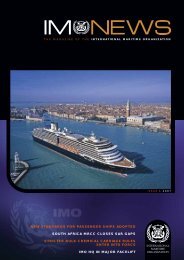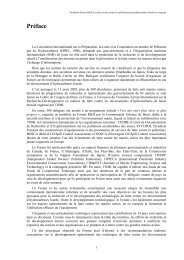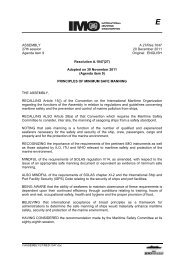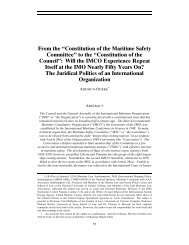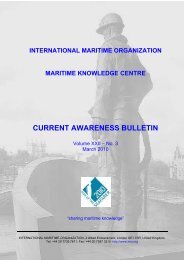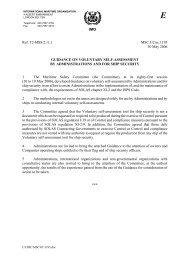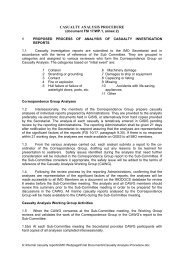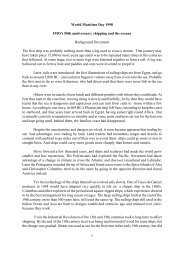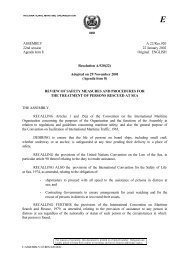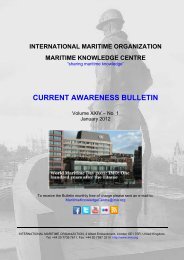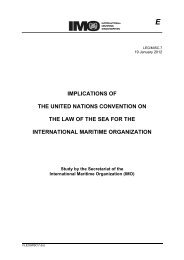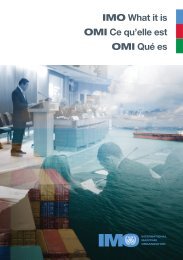Radioactive Waste Disposal at Sea: Public Ideas ... - IMO
Radioactive Waste Disposal at Sea: Public Ideas ... - IMO
Radioactive Waste Disposal at Sea: Public Ideas ... - IMO
Create successful ePaper yourself
Turn your PDF publications into a flip-book with our unique Google optimized e-Paper software.
Changing the Global Ocean Dumping Regime 133<br />
presented a formal anti-dumping petition, representing seventy organiz<strong>at</strong>ions<br />
with a total of more than 12 million members, to the Japanese Diet. 4<br />
The Japanese government was also asked to send officials to the islands for<br />
discussions. Encouraged by the United St<strong>at</strong>es, Japanese scientists and politicians<br />
toured the region, trying to persuade governments th<strong>at</strong> the dumping<br />
was safe. The campaign failed, however, and the Foreign Minister of New<br />
Guinea subsequently told the UN General Assembly th<strong>at</strong> the long-term<br />
effects of dumping could be c<strong>at</strong>astrophic (Callick 1980, p. 40). In October<br />
of 1980, the governors of Hawaii, Guam, American Samoa, and the<br />
Northern Mariana Islands issued a st<strong>at</strong>ement opposing the dumping of<br />
radioactive waste planned by Japan and the United St<strong>at</strong>es and declared th<strong>at</strong><br />
their organiz<strong>at</strong>ion, the Pacific Basin Development Council, “totally opposes<br />
the dumping of radioactive nuclear waste in any part of the Pacific Basin”<br />
(Trumbull 1980). 5<br />
In February of 1981 the Japanese government indic<strong>at</strong>ed th<strong>at</strong>, in response<br />
to the protests, it had put off its plans to begin experimental dumping l<strong>at</strong>er<br />
the same year (Kamm 1981). 6 A complex combin<strong>at</strong>ion of government consider<strong>at</strong>ions<br />
and domestic opposition apparently led to th<strong>at</strong> decision. 7<br />
Instead, Japan hoped to allay the fears of the Oceanian and Southeast Asian<br />
countries and then to dump small amounts of radioactive waste; only if th<strong>at</strong><br />
proved safe (as was expected) would full-scale dumping begin, probably in<br />
1987 or l<strong>at</strong>er (Ishihara 1982, pp. 469–470). In August of 1984, however,<br />
officials of the Japanese Science and Technology Agency reportedly admitted<br />
th<strong>at</strong> they were prepared to break their 1980 assurance not to dump<br />
without the consent of the Pacific n<strong>at</strong>ions (Dibblin 1985a, pp. 18–19). 8<br />
After yet another uproar, represent<strong>at</strong>ives of the same agency assured th<strong>at</strong><br />
dumping would happen only “with the understanding” of the Pacific<br />
n<strong>at</strong>ions (Dibblin 1985b, p. 21).<br />
There also existed a real possibility th<strong>at</strong> the United St<strong>at</strong>es, after a pause<br />
of almost 20 years, would resume ocean dumping of some forms of radioactive<br />
waste. Toward the end of the 1970s, the United St<strong>at</strong>es’ regul<strong>at</strong>ion of<br />
ocean dumping—the essentially precautionary and prohibitory Marine<br />
Protection, Research, and Sanctuaries Act of 1972, examined in chapters 4<br />
and 5—came under some <strong>at</strong>tack. There were indic<strong>at</strong>ions th<strong>at</strong> existent stringent<br />
ocean dumping regul<strong>at</strong>ion would be relaxed as Congress and the<br />
courts became painfully aware of some of the realities of strict regul<strong>at</strong>ion,<br />
namely considerable pollution control costs and insufficient altern<strong>at</strong>ives.



